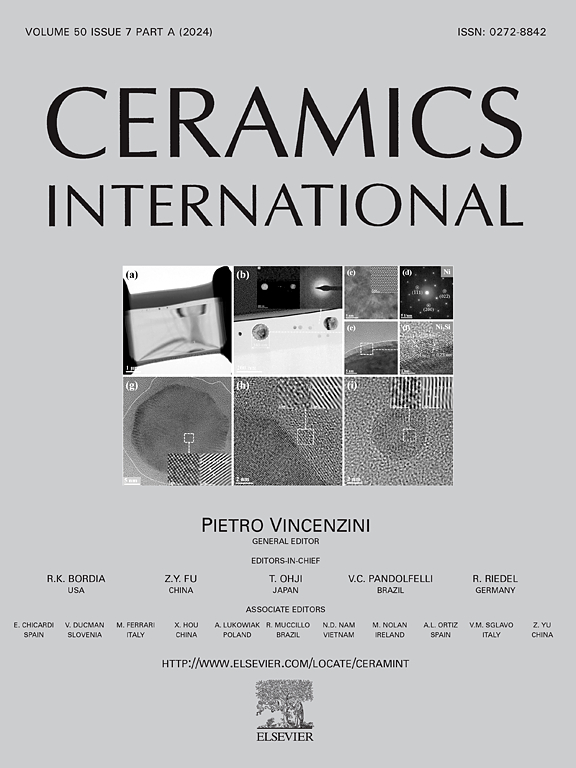Effect of TiO2 on B2O3-SiO2-Al2O3-Na2O-BaO glass lubricant: Viscosity, structure, melting behavior and wettability
IF 5.1
2区 材料科学
Q1 MATERIALS SCIENCE, CERAMICS
引用次数: 0
Abstract
Glass lubricants with suitable viscosity, softening temperature and wettability are critical for the high efficiency production of titanium alloys in hot extrusion process. A novel glass lubricant, (26.29–0.263x)B2O3-(41.19–0.412x)SiO2-(6.13–0.061x)Al2O3-(11.39–0.114x)Na2O-(15–0.15x)BaO-xTiO2, was investigated in this paper. The effect of TiO2 content on its viscosity, structure, melting behavior and wettability was investigated from 900 °C to 1100 °C. The results showed that the viscosity value at 950 °C was decreased by 42.83 % from 48.8 Pa s to 27.9 Pa s, when TiO2 content was increased from 0 wt% to 12 wt%. The glass deformation, softening, hemispheric and flow temperatures were increased with an increased TiO2 content, and the sample T2 (3 wt% TiO2) showed a good wettability with the Ti-6Al-4V alloy matrix. X-ray photoelectron spectroscopy fitting and molecular dynamics simulations due to show that the increased amounts of Q2, Q3, Q4, [BO3], [AlO4], and [TiO4] in the melts with an increased TiO2 content lead to a weakened network homogeneity and symmetry, and consequently a reduced viscosity. Furthermore, lubricant T2 was recommended due to its softening temperature value of 759.1 °C, wetting angle value of 8.1° and viscosity value of 46.6 Pa s at 950 °C, and a small viscosity variation was observed from 950 °C to 1100 °C, which is a typical temperature change in TC4 hot extrusion.
TiO2对B2O3-SiO2-Al2O3-Na2O-BaO玻璃润滑剂的影响:粘度、结构、熔融行为和润湿性
具有合适粘度、软化温度和润湿性的玻璃润滑剂是钛合金热挤压高效生产的关键。本文研究了一种新型玻璃润滑剂(26.29 - 0.262 x)B2O3-(41.19-0.412x)SiO2-(6.13-0.061x)Al2O3-(11.39-0.114x)Na2O-(15-0.15x)BaO-xTiO2。在900 ~ 1100℃范围内考察了TiO2含量对其粘度、结构、熔融行为和润湿性的影响。结果表明,当TiO2含量从0 wt%增加到12 wt%时,950℃时的粘度值从48.8 Pa s降低到27.9 Pa s,降低了42.83%;随着TiO2含量的增加,玻璃的变形温度、软化温度、半球温度和流动温度均有所提高,样品T2 (3 wt% TiO2)与Ti-6Al-4V合金基体具有良好的润湿性。x射线光电子能谱拟合和分子动力学模拟表明,随着TiO2含量的增加,熔体中Q2、Q3、Q4、[BO3]、[AlO4]和[TiO4]的含量增加,导致网络均匀性和对称性减弱,从而降低粘度。推荐T2润滑油,其在950℃时的软化温量值为759.1℃,润湿角值为8.1°,粘度值为46.6 Pa s,在950℃至1100℃范围内粘度变化较小,是TC4热挤压过程中典型的温度变化。
本文章由计算机程序翻译,如有差异,请以英文原文为准。
求助全文
约1分钟内获得全文
求助全文
来源期刊

Ceramics International
工程技术-材料科学:硅酸盐
CiteScore
9.40
自引率
15.40%
发文量
4558
审稿时长
25 days
期刊介绍:
Ceramics International covers the science of advanced ceramic materials. The journal encourages contributions that demonstrate how an understanding of the basic chemical and physical phenomena may direct materials design and stimulate ideas for new or improved processing techniques, in order to obtain materials with desired structural features and properties.
Ceramics International covers oxide and non-oxide ceramics, functional glasses, glass ceramics, amorphous inorganic non-metallic materials (and their combinations with metal and organic materials), in the form of particulates, dense or porous bodies, thin/thick films and laminated, graded and composite structures. Process related topics such as ceramic-ceramic joints or joining ceramics with dissimilar materials, as well as surface finishing and conditioning are also covered. Besides traditional processing techniques, manufacturing routes of interest include innovative procedures benefiting from externally applied stresses, electromagnetic fields and energetic beams, as well as top-down and self-assembly nanotechnology approaches. In addition, the journal welcomes submissions on bio-inspired and bio-enabled materials designs, experimentally validated multi scale modelling and simulation for materials design, and the use of the most advanced chemical and physical characterization techniques of structure, properties and behaviour.
Technologically relevant low-dimensional systems are a particular focus of Ceramics International. These include 0, 1 and 2-D nanomaterials (also covering CNTs, graphene and related materials, and diamond-like carbons), their nanocomposites, as well as nano-hybrids and hierarchical multifunctional nanostructures that might integrate molecular, biological and electronic components.
 求助内容:
求助内容: 应助结果提醒方式:
应助结果提醒方式:


